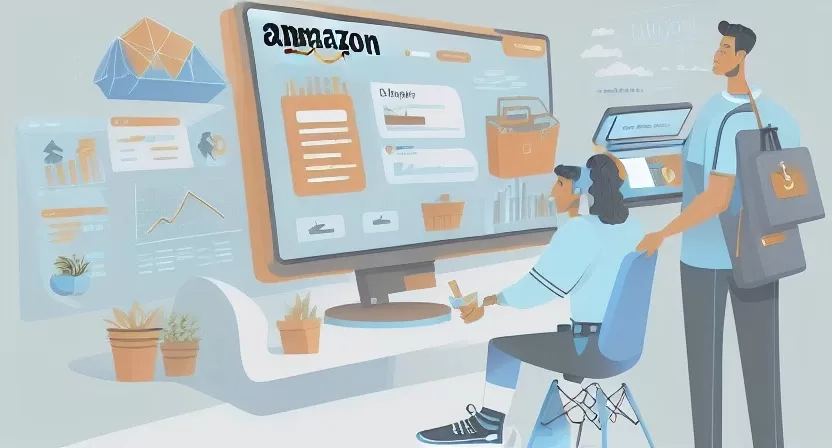Step-by-Step Guide to Selling on Amazon FBA
Updated on October 14, 2023 by Tim Donahue
Begin selling on Amazon with this quick start guide: Step-by-Step Guide to Selling on Amazon FBA
If you’re a small business owner looking to sell your products online, Amazon FBA (Fulfillment by Amazon) can be a great option. It allows you to store your inventory in Amazon’s fulfillment centers and have Amazon handle the shipping and handling.
However, getting started with Amazon FBA can seem overwhelming at first. In this step-by-step guide, we’ll walk you through the process of setting up your Amazon FBA account, sourcing your products, sending your inventory to Amazon, and launching your products. Let’s dive in!

Also see our Ultimate Guide to Sourcing Products for Amazon FBA >>
What’s the Difference Between Amazon FBA and Regular Amazon Selling?
When it comes to selling on Amazon, there are two main options: selling as a regular Amazon seller and selling through Amazon FBA. While both options allow you to sell your products on Amazon’s platform, there are some key differences to consider.
The main differences between Amazon FBA and regular Amazon selling are:
- With Amazon FBA, Amazon handles the shipping and fulfillment process for you, while with regular Amazon selling, you are responsible for shipping the products to the customer yourself
- Amazon FBA comes with additional fees, such as storage fees and fulfillment fees
- With regular Amazon selling, you have more control over the shipping and fulfillment process, while with Amazon FBA, you have less control
Ultimately, the decision to use Amazon FBA or regular Amazon selling depends on your business needs and goals. Consider the costs, benefits, and level of control you want over the shipping and fulfillment process when deciding which option is right for you.
Begin by Learning All You Can
Watch as many YouTube videos on this topic as you can. Read as many blog posts like this one as possible. It’s cheap to educate yourself and you really want to understand as much as possible about this before moving ahead.
Create a Financial Projection To See What Could Happen
Next, create a simple “back of the napkin” financial projection to see what would happen if you paid X for your products, sold then for Y, and paid Amazon fees. How much profit could you make, after shipping and tax and Amazon FBA fees?
It’s good to have a rough idea before proceeding!
Register for an Amazon Seller Account
The first step to selling on Amazon FBA is to register for an Amazon seller account. This involves creating an account and choosing between an individual or professional selling plan.
An individual plan is best for small businesses that sell fewer than 40 items per month, while the professional plan is better for larger businesses that sell more than 40 items per month. Once you’ve chosen your plan, you’ll need to set up your payment method.
Source Your Products
To sell on Amazon FBA, you’ll need to source products to sell. This can be a process of trial and error before landing on the one that resonates with your audience. It’s important to research the market demand and competition, decide on a product niche, research suppliers and manufacturers, order samples and test products, and then decide on a product and negotiate terms with your supplier.
The most common place to source your products is AliExpress or AliBaba.
Set Up Your Amazon FBA Account
Once you have your products ready to sell, it’s time to set up your Amazon FBA account. This involves creating an FBA account, setting up your shipping settings, and creating product listings. Your product listings should be optimized for search by including relevant keywords in your title and description.
Send Your Inventory to Amazon
After creating your product listings, you’ll need to send your inventory to Amazon’s fulfillment center. This involves preparing your inventory for shipment, creating a shipment plan, and shipping your products to Amazon. Once your inventory is received, Amazon takes care of the storage and shipping.
Launch Your Products and Optimize Your Listings
After sending your inventory to Amazon, it’s time to launch your products and start driving sales. To do this, you’ll need to optimize your product listings for search, utilize Amazon advertising to drive traffic to your listings, and monitor and respond to customer feedback and reviews.
Manage Your Inventory and Sales
As your products start to sell, it’s important to manage your inventory levels and adjust prices and promotions as needed. You should also stay up to date on Amazon policies and fees to avoid any surprises.
In Summary: The Key Concepts
To start and succeed in selling on Amazon FBA as a small business owner, you should follow these basic steps:
- Register for an Amazon seller account and choose between an individual or professional selling plan
- Source your products by deciding on a product niche, researching suppliers and manufacturers, ordering samples and testing products, and negotiating terms with your supplier
- Set up your Amazon FBA account by creating an FBA account, setting up your shipping settings, and creating product listings
- Send your inventory to Amazon’s fulfillment center by preparing your inventory for shipment, creating a shipment plan, and shipping your products to Amazon
- Launch your products and optimize your listings by optimizing your product listings for search, utilizing Amazon advertising to drive traffic to your listings,
and monitoring and responding to customer feedback and reviews - Manage your inventory and sales by tracking your inventory levels, adjusting prices and promotions as needed, and staying up to date on Amazon policies and fees
Remember that success on Amazon FBA doesn’t happen overnight. It takes time, effort, and patience to build a successful business. But by following these steps and staying committed to your goals, you can start and grow a profitable Amazon FBA business as a small business owner.
Some additional tips to keep in mind:
- Research your competitors to see what they’re doing well and what you can do better
- Consider joining Amazon’s FBA program to take advantage of their logistics and customer service support
- Don’t forget to factor in Amazon fees and shipping costs when pricing your products
- Continuously monitor and adjust your pricing, inventory, and marketing strategies to stay competitive and profitable
By following these tips and steps, you can start and succeed in selling on Amazon FBA as a small business owner. Good luck!
